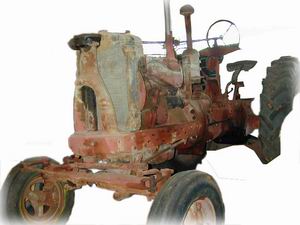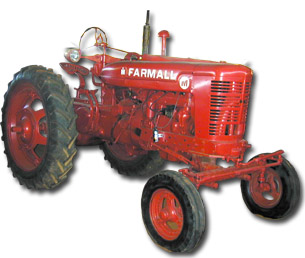Farmall, M, 1940, Kibbutz Reim
THE HISTORY OF THE FARMALL-M
The Farmall was designed during the 1940’s by the famous McCormick International company somewhere in the USA. It arrived in this country in 1950, to reinforce the spirit of mechanization of the pioneering agricultural settlements in Israel. In this way kibbutz Re’im, previously Tel-Jama, was able to benefit from its very important services.
The kibbutz had two other tractors from the same company - a small “Farmall cab” used mainly in our vegetable garden whose rusty chassis still stands in the kindergarten and a second tractor of similar size, the “Farmall-M” but with normal front wheels.
What characterized our Farmall were the two close-set front wheels underneath the radiator. At first it seemed to be a three-wheeled tractor. We farmers were hesitant to drive it fearing it would overturn on us but we soon got used to it and it became everybody’s baby!
We all wanted to work on it in the field and that was arranged. The tractor used both petrol and kerosene… a small tank of petrol and a large one of kerosene. The petrol was used for speedy ignition and after running for a few minutes to warm up the engine we switched over to kerosene with a pipe common to both kinds of fuel. There was an electric ignition system but usually we used a manual crank-handle because the battery was generally empty. Because of the construction of the front wheels the tractor was used mostly for work on hard ground (not for ploughing). On loose ground it simply dug itself in.
When it arrived in the kibbutz it was used for shift-work. It ran at a speed of 35-40 k.p.h to the delight of the members who imagined they were riding on a ground-to-ground rocket.
Later it was used for spreading fertilizer in the fields, harvesting fodder, piling fodder and straw and cultivating crops in rows such as sorghum, safflower etc.
In the sowing season it brought seeds to the fields and bales of straw back to the kibbutz during the summer months.
There was a small problem in carrying out the work in the fields. Because of the close-set wheels it was difficult to make a straight furrow. When the rear wheel was in line with the front wheel it was easy to keep a straight line. Not so when the front wheels were together in the centre of the tractor: One day when a farmer was working in the fields spreading fertilizer he saw a hole which was in fact the opening of a well. He thought that he would be able to get straight through but didn't take into consideration that the rear wheels were not in line with the front ones. The front wheels by-passed the hole but the back wheel fell straight into it. It was lucky that the circumference of the back wheel was bigger than the circumference of the opening to the well.
A Closing Story
One winter evening I was asked by the agricultural authorities to return a large quantity of fertilizer to kibbutz Gan Shlomo and to get back the same night. Naturally I asked for the Farmall for the job. By the time we got to the Sa’ad intersection it was dark so I switched on the lights and carried on. At the Hodiya intersection the engine cut out suddenly. I tried to get it going again but eventually had to get help. They told me that if the lights were on the tractor would not move because the battery was empty and the regulator could not produce electricity for the plugs and the lights. In other words I would have to travel without lights. I asked the guard who was sitting on the fertilizer to light a match each time he saw lights from a car behind us. That’s how we got to the Bilu roundabout but we didn’t go round it….we got on it. We arrived at Gan Shlomo at midnight and decided to stay there until morning.
It rained during the night and the tractor was outside. We got up in the morning, and got on our way. After a short time the engine cut out… After a great deal of trying, we discovered that there was water in the kerosene tank so I emptied the carburetor- cup and got the engine going with the small amount of petrol that was left. Opposite Tel Nof, on the bridge, the engine stopped dead and it was impossible to do anything about it. We remained on the bridge and waited for a miracle or the police!
After half an hour, a truck from the kibbutz appeared. He recognized us, stopped and our problem was solved. A strong tow-bar was brought and that’s how we got home after dark.
But things change. Little by little, the Farmall was moved aside. Now it is used for local work in the kibbutz and when it goes on pension (as I will too), it will be placed, after 35 years of service, on a pedestal at the entrance to the kibbutz in honour of the agriculturalists of the past. The era of the Farmall tractor has ended… we’ll remember it forever.
Reuven Lilati. Kibbutz Re’im.

